The NVIDIA GeForce GTX 980 Ti Review
by Ryan Smith on May 31, 2015 6:00 PM ESTPower, Temperature, & Noise
As always, last but not least is our look at power, temperature, and noise. Next to price and performance of course, these are some of the most important aspects of a GPU, due in large part to the impact of noise. All things considered, a loud card is undesirable unless there’s a sufficiently good reason – or sufficiently good performance – to ignore the noise.
As the GM200 flagship card, GTX Titan X gets the pick of the litter as far as GM200 GPUs go. GTX Titan X needed fully-functional GM200 GPUs, and even then needed GPUs that were good enough to meet NVIDIA’s power requirements. GTX 980 Ti on the other hand, as a cut-down/salvage card, gets second pick. So we expect to see these chips be just a bit worse; to have either functional units that came out of the fab damaged, or have functional units that have been turned off due to power reasons.
| GeForce GTX Titan X/980 Voltages | ||||
| GTX Titan X Boost Voltage | GTX 980 Ti Boost Voltage | GTX 980 Boost Voltage | ||
| 1.162v | 1.187v | 1.225v | ||
Looking at voltages, we can see just that in our samples. GTX 980 Ti has a slightly higher boost voltage – 1.187v – than our GTX Titan X. NVIDIA sometimes bins their second-tier cards for lower voltage, but this isn’t something we’re seeing here. Nor is there necessarily a need to bin in such a manner since the 250W TDP is unchanged from GTX Titan X.
| GeForce GTX 980 Ti Average Clockspeeds | |||
| Game | GTX 980 Ti | GTX Titan X | |
| Max Boost Clock | 1202MHz | 1215MHz | |
| Battlefield 4 |
1139MHz
|
1088MHz
|
|
| Crysis 3 |
1177MHz
|
1113MHz
|
|
| Mordor |
1151MHz
|
1126MHz
|
|
| Civilization: BE |
1101MHz
|
1088MHz
|
|
| Dragon Age |
1189MHz
|
1189MHz
|
|
| Talos Principle |
1177MHz
|
1126MHz
|
|
| Far Cry 4 |
1139MHz
|
1101MHz
|
|
| Total War: Attila |
1139MHz
|
1088MHz
|
|
| GRID Autosport |
1164MHz
|
1151MHz
|
|
| Grand Theft Auto V |
1189MHz
|
1189MHz
|
|
The far more interesting story here is GTX 980 Ti’s clockspeeds. As we have pointed out time and time again, GTX 980 Ti’s gaming performance trails GTX Titan X by just a few percent, this despite the fact that GTX 980 Ti is down by 2 SMMs and is clocked identically. On paper there is a 9% performance difference that in the real world we’re not seeing. So what’s going on?
The answer to that is that what GTX 980 Ti lacks in SMMs it’s making up in clockspeeds. The card’s average clockspeeds are frequently two or more bins ahead of GTX Titan X, topping out at a 64MHz advantage under Crysis 3. All of this comes despite the fact that GTX 980 Ti has a lower maximum boost clock than GTX Titan X, topping out one bin lower at 1202MHz to GTX Titan X’s 1215MHz.
Ultimately the higher clockspeeds are a result of the increased power and thermal headroom the GTX 980 Ti picks up from halving the number of VRAM chips along with disabling two SMMs. With those components no longer consuming power or generating heat, and yet the TDP staying at 250W, GTX 980 Ti can spend its power savings to boost just a bit higher. This in turn compresses the performance gap between the two cards (despite what the specs say), which coupled with the fact that performance doesn't scale lineraly with SMM count or clockspeed (you rarely lose the full theoretical performance amount when shedding frequency or functional units) leads to the GTX 980 Ti trailing the GTX Titan X by an average of just 3%.
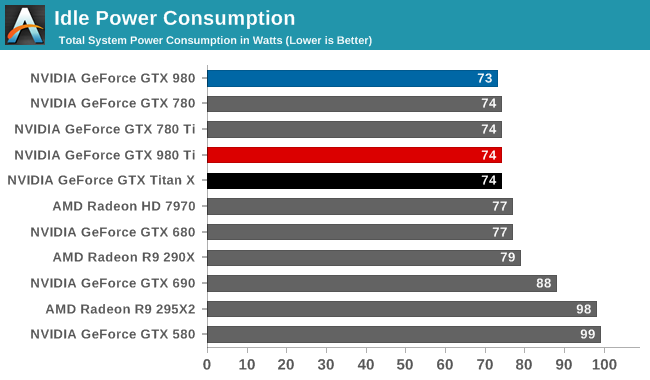
Starting off with idle power consumption, there's nothing new to report here. GTX 980 Ti performs just like the GTX Titan X, which at 74W is second only to the GTX 980 by a single watt.
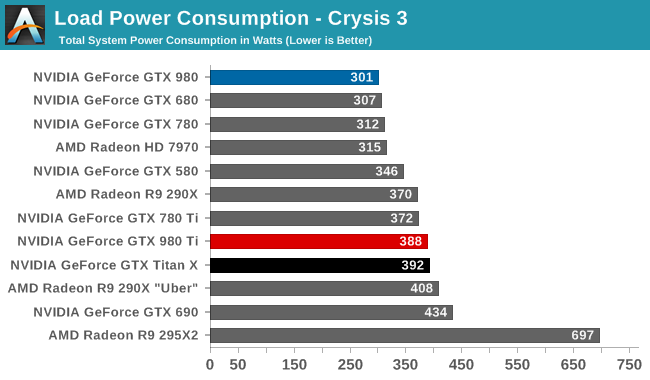
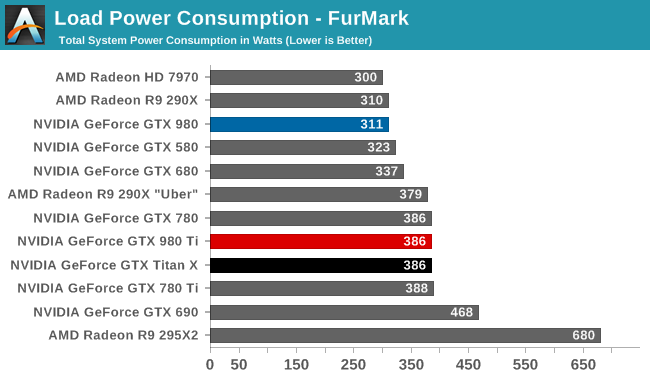
Meanwhile load power consumption is also practically identical to the GTX Titan X. With the same GPU on the same board operating at the same TDP, GTX 980 Ti ends up right where we expect it, next to GTX Titan X. GTX Titan X did very well as far as energy efficiency is concerned – setting a new bar for 250W cards – and GTX 980 Ti in turn does just as well.
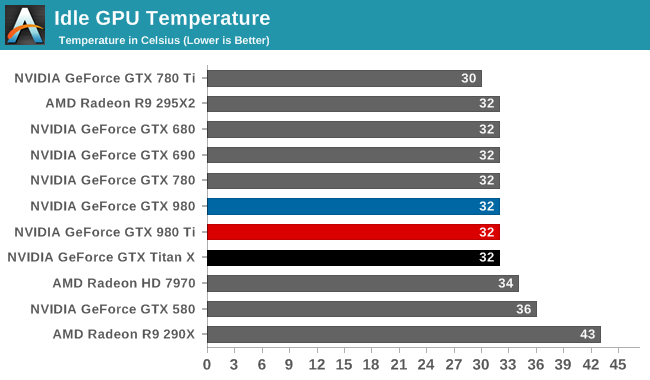
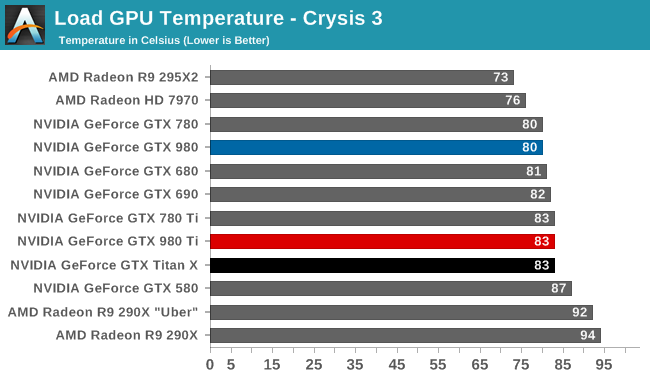
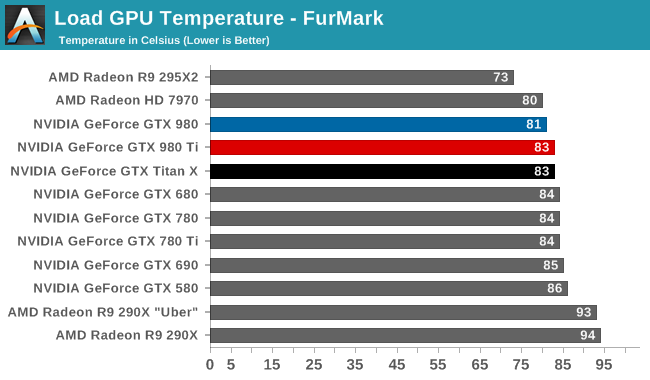
As was the case with power consumption, video card temperatures are similarly unchanged. NVIDIA’s metal cooler does a great job here, keeping temperatures low at idle while NVIDIA’s GPU Boost mechanism keeps temperatures from exceeding 83C under full load.
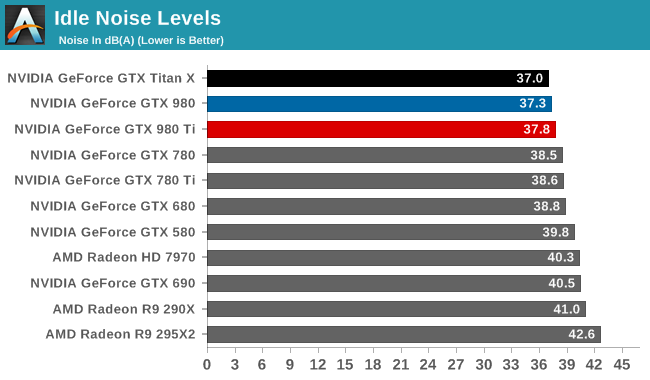
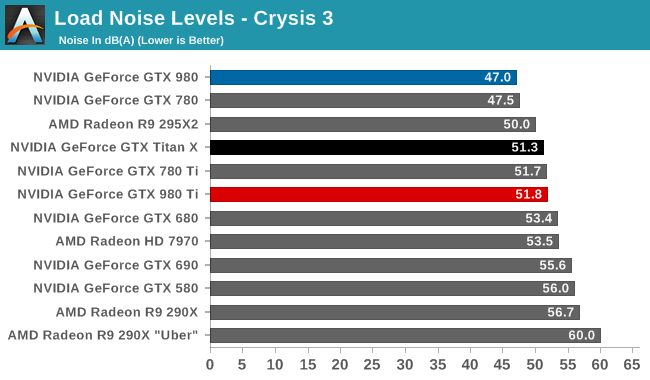
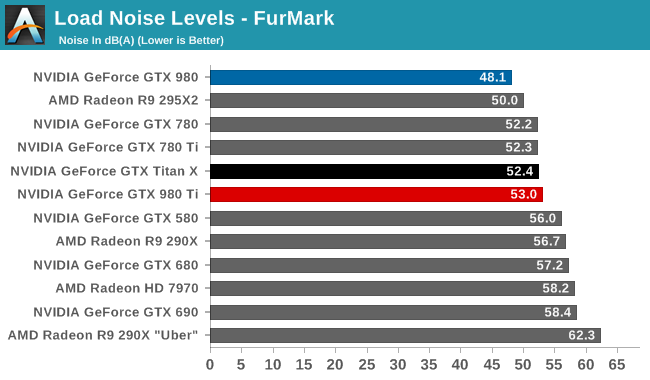
Finally for noise, the situation is much the same. Unexpected but not all that surprising, the GTX 980 Ti ends up doing a hair worse than the GTX Titan X here. NVIDIA has not changed the fan curves or TDP, so this ultimately comes down to manufacturing variability in NVIDIA’s metal cooler, with our GTX 980 Ti faring ever so slightly worse than the Titan. Which is to say that it's still right at the sweet spot for noise versus power consumption, dissipating 250W at no more than 53dB, and once again proving the mettle of NVIDIA's metal cooler.










290 Comments
View All Comments
Klimax - Tuesday, June 2, 2015 - link
Just small bug in your article:Page "GRID Autosport" has one paragraph from previous page.
"Switching out to another strategy game, even given Attila’s significant GPU requirements at higher settings, GTX 980 Ti still doesn’t falter. It trails GTX Titan X by just 2% at all settings."
As for theoretical pixel test with anomalous 15% drop from Titan X, there is ready explanation:
Under specific conditions there won't be enough power to push those two Raster engines with cut down blocks. (also only three paths instead of four)
Ryan Smith - Wednesday, June 3, 2015 - link
Fixed. Thanks for pointing that out.bdiddytampa - Tuesday, June 2, 2015 - link
Really great and thorough review as usual :-) Thanks Ryan!Hrobertgar - Tuesday, June 2, 2015 - link
Today, Alienware is offering 15" laptops with an option for an R9-390x. Their spec sheet isn't updated, nor could I find updated specs for anything other than R9-370 on AMD's own website. Are you going to review some of these R9-300 series cards anytime soon?Hrobertgar - Tuesday, June 2, 2015 - link
When I went to checkout (didn't actually buy - just checking schedule) it indicated 6-8 day shipping with the R9-390X.3DJF - Tuesday, June 2, 2015 - link
Ummm....$599 for R9 295X2?......where exactly? every search i have done for that card over the last 4 months up to today shows a LOWEST price of $619.Ryan Smith - Wednesday, June 3, 2015 - link
It is currently $599 after rebate over at Newegg.Casecutter - Tuesday, June 2, 2015 - link
From most result the 980Ti offer 20% more @1440p than a 980 (GM204) and given the 980Ti cost like 18-19% more that the orginal MSRP of the 980 ($550) It's really not any big thing.Given GM200 a 38% larger die, and 38% more SU's over a GM204 and you get 20% increase? It worse when a full TitanX is considered, that has 50% more SU's and the TitanX get perhaps 4% more in FpS over the 980Ti. This points to the fact that Maxwell doesn't scale. Looking at power the 980Ti is needing approx. 28% more power, which is not the worst but is starting to indicate there a losses as Nvidia scaled it up.
chizow - Tuesday, June 2, 2015 - link
Well, I guess its a good thing 980Ti isn't just 20% faster than the 980 then lol.CiccioB - Thursday, June 4, 2015 - link
This is obviously a comment by a frustrated AMD fan.Maxwell scales perfectly as you didn't consider the frequency it runs.
GM200 is 50% more than a GM204 in all resources. But those GPU run at about 0.86% of GM204 frequency (1250 vs 1075). If you can do simple math, you'll see that for any 980 results, if you multiply it by 1.5 and then for 0.86 (or directly for 1.3, that means 30% more) you'll find almost exactly the numbers the 980Ti bench shows.
Now that the new 980 $500 price, do the same and... yes, it is $650 for 980Ti.
Oh, the die size... let's see... 398mm^2of GM204 * 1.5 = 597mm^2 which compares almost exactly with the calculated 601m^2 of GM200.
Pretty simply. It shows everything scales perfectly in nvidia house. Seen custom cards are coming, we'll see GM200 going to 50% more than GM204 at same frequency. Yet these cards will consume a bit more, as expected.
You cannot say the same for AMD architecture though, as with smaller chips GCN is somewhat on par or even better with respect to nvidia for perf/mm^2, but as soon as real crunching power is requested GCN becomes extremely inefficient under the point of both perf/Watt or perf/mm^2.
If you tried to plant a doubt about the quality of this GM200 or Maxwell architecture in general, sorry, you choose the wrong architecture/chip/method. You simply failed.